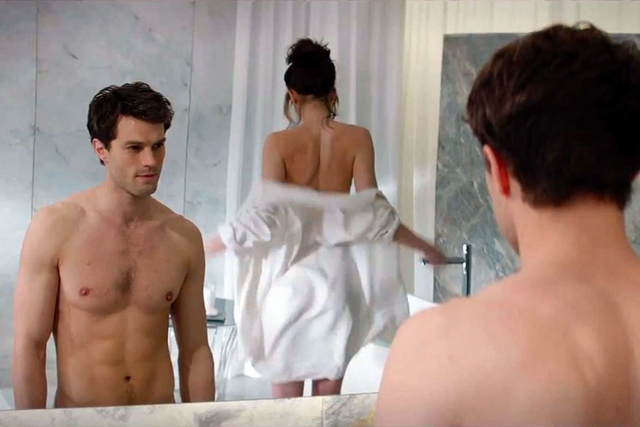When I take my dad to watch the Metropolitan Opera broadcasts on Saturday mornings at the movie theater near my house, I know what to expect: slow-moving senior citizens who force the staff to bend over backwards satisfying their demands before the performance starts. That’s what made this past weekend so surprising. The same people were there, but many of them were going to see Fifty Shades of Grey instead.
The irony in the title didn’t seem to trouble them. Nor did the fact that one of the operas they were skipping — it was a double bill — dealt with the same subject matter as E.L. James’s massively successful novel. But it distracted me more and more as I tried to watch the performance of Tchaikovsky’s Iolanta. By the time the intermission came and I wheeled my dad out to use the restroom, I could think of nothing else.
To be sure, it’s not uncommon to see senior citizens at culture events in a place like Tucson, where many highly educated people from cold-weather places like New York, Boston and Chicago like to spend the winter. Truth be told, the city’s arts scene would probably collapse without their patronage. Even though I know this, however, I can’t clear my head of the stereotypes associated with their demographic.
Retirees may have deeper pockets than working people and also be more willing to donate money to support non-profit organizations, but they are also supposed to be more conservative than the population as a whole. In the city’s northern suburbs where I live, they also vote overwhelmingly Republican. And most of them give at least the impression of probity as well. What possible appeal could Fifty Shades of Grey hold for them?
That’s what I was thinking Saturday morning, anyway. Afterwards, as I reflected on the experience, I came to the uncomfortable realization that quite a few of these gray-haired moviegoers belonged to the generation famous for celebrating “sex, drugs and rock and roll” as a way to reject the cautiousness of their parents, who had experienced the Great Depression. And many more, though born a decade or more earlier, had been exposed to the sort of “Swinging Sixties” lifestyle depicted on television’s Mad Men.
Indeed, there was a good chance that a sizable portion of the retirees I’d thought of as too staid to be interested in a narrative about dominance and submission had done things — and perhaps done them over and over — that people of my generation, who went through their teens and twenties at the height of the AIDS crisis and were bombarded with endless injunctions to “Just say no!”, had never had the desire or opportunity to pursue. In short, who was I to prejudge?
I resolved to return to the theater to see Fifty Shades of Grey at the first possible opportunity to ponder my own reactions and speculate on those of my elders. Halfway into the screening, it became clear that I had overcorrected for my initial stereotyping. Never has a film with so many sex scenes — Dakota Johnson’s breasts practically qualify as a supporting actress — been so utterly lacking in sexiness. The story felt like an instructional video. That genre can provide turn-ons, certainly, as plenty of X-rated fare and even “respectable” films like Dangerous Liaisons have demonstrated. But in Fifty Shades of Grey the erotic possibilities of pedagogy, with an experienced partner showing the ropes — in this case literally — to a novice are ruthlessly suppressed by a fixation on contractual obligations.
Yes, Anastasia and Christian spend a lot of time having sex in the film. Yet they seem to spend even more time discussing the rules and regulations surrounding their encounter. I suppose it is admirable that Christian takes every opportunity to insist that Anastasia understands what she is getting into and consents to it fully. From one perspective, he could even be considered a role model. To me, though, watching their relationship develop held all the excitement of watching corporate lawyers negotiate a complex business deal.
Maybe that’s the point. Maybe the average woman — both the novel and the film have attracted disproportionately female audiences — finds legalese more compelling that the literature Anastasia and Christian both profess to love. If it’s difficult to account for taste, it’s even harder to account for desire. Nevertheless, I can’t help but think that the ascendance of this contractual erotica testifies to the decline of romance in our world. When you fantasize about limiting exposure to liability, the risqué no longer seems very risky at all.
That’s why my thoughts eventually drifted back to the second opera broadcast by the Met on Saturday, Béla Bartók’s masterpiece Bluebeard’s Castle. Brilliantly staged by Mariusz Trelinski, who once again uses video projection — he is also a film director — to complement his minimalist approach with props, this performance revealed new depths of meaning in this extremely disturbing tale of sexual obsession and violence.
Like Fifty Shades of Grey, the production featured a male lead tortured by his own compulsions and a female counterpart perversely incapable of heeding the limits he set in the hopes of restraining himself. But whereas Christian and Anastasia’s tale appears to be roughly as dangerous as a trip to the shopping mall, Bluebeard and Judith’s proves about as dark as it’s possible to be.
There are numerous reasons for this, from the nature of the dialogue to the quality of the acting to the role that music plays in accentuating crucial junctures in the narrative. Ultimately, though, by far the biggest difference between the two stories is that Bluebeard’s Castle is far less sanguine about the outcome of asymmetrical relationships. Bluebeard may not consciously want his relationship with Judith to turn out like his previous marriages, but his wealth and power make it almost inevitable that his inner urges will have their way.
Like Christian, he proposes a kind of contract to his female counterpart. However Bluebeard’s appeal to law turns out to be futile. The opera understands that dominance is not like an article of clothing that can be donned and doffed at will. It is a function of one’s position in society. And in a patriarchy like Bartók’s Hungary — or the United States today, for that matter — it naturally follows that a woman will be at a structural disadvantage that no amount of repartee or rebellious behavior will eliminate.
I imagine that women who have reached retirement age will have internalized this depressing fact of life to a greater degree than their daughters and granddaughters, both because they grew up when gender equality was more overt and because their personal experience has taught them the hard way that their will is bound to find its way obstructed by the men in their lives. Perhaps that’s why Fifty Shades of Grey drew them in such numbers. As a fantasy, the story might prove especially compelling to those who realize how unlikely it is to ever come true.
Still, I couldn’t help but wish that both the senior citizens seeing the movie and the younger members of the audience had drifted over to the theater showing the Met’s broadcast, so that they might register the disturbing truth at the heart of that fantasy. Bluebeard’s Castle was a whole lot sexier than Fifty Shades of Grey ever could be precisely because it never loses sight of the danger that goes hand in hand with desire.
Photographs courtesy of Focus Features and the Metropolitan Opera.



